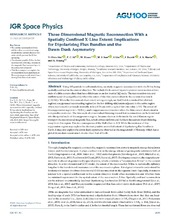Three-Dimensional Magnetic Reconnection With a Spatially Confined X-Line Extent: Implications for Dipolarizing Flux Bundles and the Dawn-Dusk Asymmetry
Peer reviewed, Journal article
Published version

Åpne
Permanent lenke
https://hdl.handle.net/1956/21891Utgivelsesdato
2019Metadata
Vis full innførselSamlinger
Originalversjon
https://doi.org/10.1029/2019ja026539Sammendrag
Using 3‐D particle‐in‐cell simulations, we study magnetic reconnection with the X‐line being spatially confined in the current direction. We include thick current layers to prevent reconnection at two ends of a thin current sheet that has a thickness on an ion inertial (di) scale. The reconnection rate and outflow speed drop significantly when the extent of the thin current sheet in the current direction is urn:x-wiley:jgra:media:jgra54890:jgra54890-math-0001. When the thin current sheet extent is long enough, we find that it consists of two distinct regions; a suppressed reconnecting region (on the ion‐drifting side) exists adjacent to the active region where reconnection proceeds normally as in a 2‐D case with a typical fast rate value ≃0.1. The extent of this suppression region is ≃O(10di), and it suppresses reconnection when the thin current sheet extent is comparable or shorter. The time scale of current sheet thinning toward fast reconnection can be translated into the spatial scale of this suppression region, because electron drifts inside the ion diffusion region transport the reconnected magnetic flux, which drives outflows and furthers the current sheet thinning, away from this region. This is a consequence of the Hall effect in 3‐D. While the existence of this suppression region may explain the shortest possible azimuthal extent of dipolarizing flux bundles at Earth, it may also explain the dawn‐dusk asymmetry observed at the magnetotail of Mercury, which has a global dawn‐dusk extent much shorter than that of Earth.